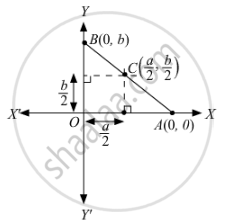Advertisements
Advertisements
प्रश्न
The vertices of a triangle are O (0, 0), A (a, 0) and B (0, b). Write the coordinates of its circumcentre.
उत्तर
The coordinates of circumcentre of a triangle are the intersection of perpendicular bisectors of any two sides of the triangle.
Thus, the coordinates of circumcentre of triangle OAB are \[\left( \frac{a}{2}, \frac{b}{2} \right)\], as shown in the figure.
APPEARS IN
संबंधित प्रश्न
If the line segment joining the points P (x1, y1) and Q (x2, y2) subtends an angle α at the origin O, prove that
OP · OQ cos α = x1 x2 + y1, y2
The vertices of a triangle ABC are A (0, 0), B (2, −1) and C (9, 2). Find cos B.
Find the coordinates of the centre of the circle inscribed in a triangle whose vertices are (−36, 7), (20, 7) and (0, −8).
Find the distance between P (x1, y1) and Q (x2, y2) when (i) PQ is parallel to the y-axis (ii) PQ is parallel to the x-axis.
Find a point on the x-axis, which is equidistant from the points (7, 6) and (3, 4).
Find the locus of a point equidistant from the point (2, 4) and the y-axis.
A point moves so that the difference of its distances from (ae, 0) and (−ae, 0) is 2a. Prove that the equation to its locus is \[\frac{x^2}{a^2} - \frac{y^2}{b^2} = 1\]
Find the locus of a point such that the sum of its distances from (0, 2) and (0, −2) is 6.
Find the locus of a point which is equidistant from (1, 3) and the x-axis.
A (5, 3), B (3, −2) are two fixed points; find the equation to the locus of a point P which moves so that the area of the triangle PAB is 9 units.
Find the locus of a point such that the line segments with end points (2, 0) and (−2, 0) subtend a right angle at that point.
If A (−1, 1) and B (2, 3) are two fixed points, find the locus of a point P, so that the area of ∆PAB = 8 sq. units.
Find the locus of the mid-point of the portion of the line x cos α + y sin α = p which is intercepted between the axes.
If O is the origin and Q is a variable point on y2 = x, find the locus of the mid-point of OQ.
What does the equation (x − a)2 + (y − b)2 = r2 become when the axes are transferred to parallel axes through the point (a − c, b)?
What does the equation (a − b) (x2 + y2) −2abx = 0 become if the origin is shifted to the point \[\left( \frac{ab}{a - b}, 0 \right)\] without rotation?
Find what the following equation become when the origin is shifted to the point (1, 1).
x2 − y2 − 2x +2y = 0
Find what the following equation become when the origin is shifted to the point (1, 1).
xy − x − y + 1 = 0
Find what the following equation become when the origin is shifted to the point (1, 1).
xy − y2 − x + y = 0
To what point should the origin be shifted so that the equation x2 + xy − 3x − y + 2 = 0 does not contain any first degree term and constant term?
Verify that the area of the triangle with vertices (2, 3), (5, 7) and (− 3 − 1) remains invariant under the translation of axes when the origin is shifted to the point (−1, 3).
Find what the following equation become when the origin is shifted to the point (1, 1).
x2 − y2 − 2x + 2y = 0
Verify that the area of the triangle with vertices (4, 6), (7, 10) and (1, −2) remains invariant under the translation of axes when the origin is shifted to the point (−2, 1).
In Q.No. 1, write the distance between the circumcentre and orthocentre of ∆OAB.
Three vertices of a parallelogram, taken in order, are (−1, −6), (2, −5) and (7, 2). Write the coordinates of its fourth vertex.
If the points (a, 0), (at12, 2at1) and (at22, 2at2) are collinear, write the value of t1 t2.
If the coordinates of the sides AB and AC of ∆ABC are (3, 5) and (−3, −3), respectively, then write the length of side BC.
Write the coordinates of the circumcentre of a triangle whose centroid and orthocentre are at (3, 3) and (−3, 5), respectively.
If the points (1, −1), (2, −1) and (4, −3) are the mid-points of the sides of a triangle, then write the coordinates of its centroid.
